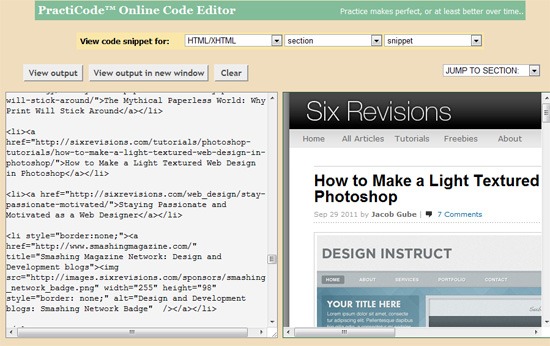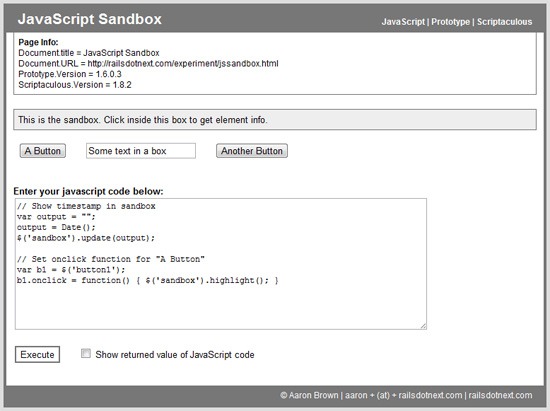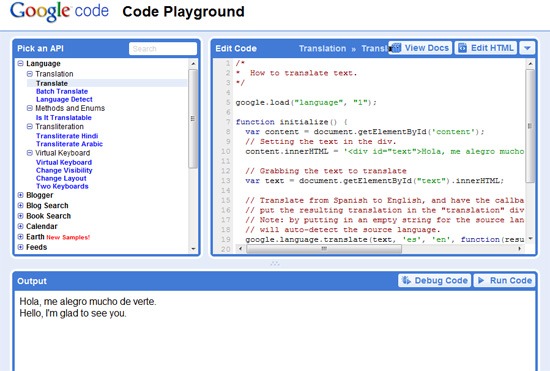- Home
- Blog
- Web Design 10 Web-based Sandbox Tools for Testing Your Code Snippets
10 Web-based Sandbox Tools for Testing Your Code Snippets
-
 8 min. read
8 min. read
-
 William Craig
William Craig CEO & Co-Founder
CEO & Co-Founder
- President of WebFX. Bill has over 25 years of experience in the Internet marketing industry specializing in SEO, UX, information architecture, marketing automation and more. William’s background in scientific computing and education from Shippensburg and MIT provided the foundation for MarketingCloudFX and other key research and development projects at WebFX.
 One of the greatest benefits the Internet provides web developers is the ability to share and collaborate with other professionals. When you’ve hit a coding roadblock, you can reach out on your social networks to see if your friends can give you a hand. When you need to debug, experiment with, and share short code snippets, sandboxing tools are immensely useful.
One of the greatest benefits the Internet provides web developers is the ability to share and collaborate with other professionals. When you’ve hit a coding roadblock, you can reach out on your social networks to see if your friends can give you a hand. When you need to debug, experiment with, and share short code snippets, sandboxing tools are immensely useful.
Why use a web-based sandbox tool instead of a testing server or a local web server stack like XAMMP or WAMP? Not having to set up and save HTML, CSS and JavaScript documents simply to test and debug small code snippets, being able to back up your code snippets remotely, and the capability of quickly linking to and showing off your work (which many of these tools can do) are the major reasons you’d want to use them. In this article, you’ll find some of the best free code sandboxing tools for testing, debugging and/or sharing your code.
Common Features
Though each tool in the list has its own unique features that might make one of them more appealing than another, you’ll find these general features in most of them:
- Simple and optimized for snippets: these tools aren’t meant to be full web-based IDEs/source code editors (like the Amy Editor and Kodingen)
- Web-based: Can run in the browser without having to install any software
- Free: You can use these tools without paying a cent, and many are even open source
- Preview pane: Allows you to see how your code will render
- Runs front-end/client-side code: Can, at the very least, run HTML, CSS and/or JavaScript
- Saving capabilities: Most tools included allow you to download your code and/or save it on-site
- Sharing capabilities: Most tools below are designed with sharing and collaboration in mind
Let’s look at some top-notch, free sandboxing tools and, for each of them, we’ll discuss some notably unique features they have, to help you make an informed decision on which one is right for you.
1. Tinkerbin
 Created by web development agency Sinefunc, Tinkerbin is a relatively new code playground that can run HTML, CSS and JavaScript, as well as CSS and JavaScript abstraction languages/metalanguages like SASS and CoffeeScript. It has keyboard shortcuts that conveniently allow you to navigate efficiently between tabs and code panes. The auto-updating preview pane is a nice feature that displays your work as you’re coding.
Created by web development agency Sinefunc, Tinkerbin is a relatively new code playground that can run HTML, CSS and JavaScript, as well as CSS and JavaScript abstraction languages/metalanguages like SASS and CoffeeScript. It has keyboard shortcuts that conveniently allow you to navigate efficiently between tabs and code panes. The auto-updating preview pane is a nice feature that displays your work as you’re coding.
2. JS Bin
 This open source sandbox tool by developer Remy Sharp is an excellent JavaScript/HTML code-testing tool. It has the option for live/real-time preview and the ability to reference (include) popular open source libraries like jQuery, MooTools, YUI and Modernizr. You can grab JS Bin’s source on GitHub if you’d like to use the tool locally.
This open source sandbox tool by developer Remy Sharp is an excellent JavaScript/HTML code-testing tool. It has the option for live/real-time preview and the ability to reference (include) popular open source libraries like jQuery, MooTools, YUI and Modernizr. You can grab JS Bin’s source on GitHub if you’d like to use the tool locally.
View documentation, tips and tutorials for this tool on JS Bin’s very own Tumblr blog.
3. JS Fiddle
 JS Fiddle is a free sandbox tool for HTML, CSS and JS that has a wonderful set of features, like the ability to reference popular JS libraries/frameworks like jQuery, YUI and MooTools and an Ajax-request-testing functionality for simulating asynchronous calls for your code. There’s a command for running JSLint that can check your JavaScript for code quality and the “Tidy Up” code-formatting command for re-indenting your code. The source code of this open source web tool is available on GitHub.
JS Fiddle is a free sandbox tool for HTML, CSS and JS that has a wonderful set of features, like the ability to reference popular JS libraries/frameworks like jQuery, YUI and MooTools and an Ajax-request-testing functionality for simulating asynchronous calls for your code. There’s a command for running JSLint that can check your JavaScript for code quality and the “Tidy Up” code-formatting command for re-indenting your code. The source code of this open source web tool is available on GitHub.
4. CSSDesk
 This online CSS/HTML sandbox tool is a slick way of testing snippets of your style sheet and markup. You have the option of changing the background of the preview pane, which is useful when you have a hard time scoping out the outcome of your CSS/HTML work due to low foreground/background contrast or for seeing how your work looks on different types of backgrounds. You can also maximize the screen viewing size of the preview pane by hiding the HTML and CSS code panes.
This online CSS/HTML sandbox tool is a slick way of testing snippets of your style sheet and markup. You have the option of changing the background of the preview pane, which is useful when you have a hard time scoping out the outcome of your CSS/HTML work due to low foreground/background contrast or for seeing how your work looks on different types of backgrounds. You can also maximize the screen viewing size of the preview pane by hiding the HTML and CSS code panes.
5. Pastebin.me
 A tool created by developer and entrepreneur Dale Harvey, Pastebin.me is a simple and clutter-free HTML/JS open source sandbox tool. The code pane flexibly resizes depending on your browser’s viewport, which is especially awesome when you’re using a widescreen monitor. It has three useful templates (“HTML”, “JavaScript” and “jQuery”) for instantly auto-populating the code pane with default HTML tags.
A tool created by developer and entrepreneur Dale Harvey, Pastebin.me is a simple and clutter-free HTML/JS open source sandbox tool. The code pane flexibly resizes depending on your browser’s viewport, which is especially awesome when you’re using a widescreen monitor. It has three useful templates (“HTML”, “JavaScript” and “jQuery”) for instantly auto-populating the code pane with default HTML tags.
6. jsdo.it
 This sandboxing tool emphasizes on community engagement and collaboration, with features that easily give you the opportunity to share your code on your social networks as well as within the site. It has a slick interface, an auto-updating preview pane and the ability to include open source JS libraries. One unique feature is the “Smart phone preview” command that opens a new browser window with the viewport sized equivalently to mobile phones.
This sandboxing tool emphasizes on community engagement and collaboration, with features that easily give you the opportunity to share your code on your social networks as well as within the site. It has a slick interface, an auto-updating preview pane and the ability to include open source JS libraries. One unique feature is the “Smart phone preview” command that opens a new browser window with the viewport sized equivalently to mobile phones.
This tool requires you to sign up and be logged-in.
7. Tryit Editor Instant
 This free and no-frills tool allows you to rapidly test your HTML markup. If you don’t need all the features that the above tools offer and simply want one for quickly testing HTML, check this one out. It auto-updates the preview pane whenever you change something in the coding pane.
This free and no-frills tool allows you to rapidly test your HTML markup. If you don’t need all the features that the above tools offer and simply want one for quickly testing HTML, check this one out. It auto-updates the preview pane whenever you change something in the coding pane.
It doesn’t have any saving and collaboration features, so this one is more of a personal tool.
8. PractiCode
 The PractiCode online code editor is a supplementary tool for Landofcode.com’s educational web design materials. Though it’s meant to be used alongside their guides and tutorials for practicing and testing code snippets while you’re reading their material, it can be used as a sandboxing tool as well. This online tool can render HTML, CSS and VBScript.
The PractiCode online code editor is a supplementary tool for Landofcode.com’s educational web design materials. Though it’s meant to be used alongside their guides and tutorials for practicing and testing code snippets while you’re reading their material, it can be used as a sandboxing tool as well. This online tool can render HTML, CSS and VBScript.
9. JavaScript Sandbox
 Are you looking for a dead-simple tool for testing your JavaScript code snippets? Look no further than the JavaScript Sandbox, which is a very austere tool when pitted against the other web-based tools already mentioned (such as Tinkerbin and JS Bin). However, to some, its uncomplicated nature may just be the thing that’s most attractive about this tool.
Are you looking for a dead-simple tool for testing your JavaScript code snippets? Look no further than the JavaScript Sandbox, which is a very austere tool when pitted against the other web-based tools already mentioned (such as Tinkerbin and JS Bin). However, to some, its uncomplicated nature may just be the thing that’s most attractive about this tool.
10. Google Code Playground
 Google offers web developers plenty of free APIs and services for things such as web fonts, Google Analytics and a content distribution network (CDN) for popular, open source JavaScript libraries (such as jQuery). Google Code Playground is a sandbox tool that gives you the ability to test and experiment with Google’s awesome APIs. Also, see the top Google products and services for people who build webites.
Google offers web developers plenty of free APIs and services for things such as web fonts, Google Analytics and a content distribution network (CDN) for popular, open source JavaScript libraries (such as jQuery). Google Code Playground is a sandbox tool that gives you the ability to test and experiment with Google’s awesome APIs. Also, see the top Google products and services for people who build webites.
Other Tools to Check Out
- Pastebin: A simple text-pasting tool that has syntax highlighting. (No live preview though)
- codepad: A web-based compiler/interpreter for server-side and software programming languages like PHP and C++
- Real-time HTML Editor: A very simple HTML previewing tool
- Ideone: An online interpreter/debugging tool that can run over 40 programming languages
Do you have a favorite web-based sandboxing tool not mentioned above? Please share it with us in the comments.
Related Content
-
 President of WebFX. Bill has over 25 years of experience in the Internet marketing industry specializing in SEO, UX, information architecture, marketing automation and more. William’s background in scientific computing and education from Shippensburg and MIT provided the foundation for MarketingCloudFX and other key research and development projects at WebFX.
President of WebFX. Bill has over 25 years of experience in the Internet marketing industry specializing in SEO, UX, information architecture, marketing automation and more. William’s background in scientific computing and education from Shippensburg and MIT provided the foundation for MarketingCloudFX and other key research and development projects at WebFX. -

WebFX is a full-service marketing agency with 1,100+ client reviews and a 4.9-star rating on Clutch! Find out how our expert team and revenue-accelerating tech can drive results for you! Learn more
Make estimating web design costs easy
Website design costs can be tricky to nail down. Get an instant estimate for a custom web design with our free website design cost calculator!
Try Our Free Web Design Cost Calculator


Web Design Calculator
Use our free tool to get a free, instant quote in under 60 seconds.
View Web Design CalculatorMake estimating web design costs easy
Website design costs can be tricky to nail down. Get an instant estimate for a custom web design with our free website design cost calculator!
Try Our Free Web Design Cost Calculator




